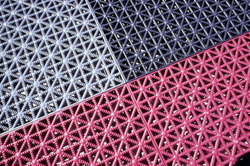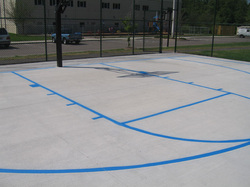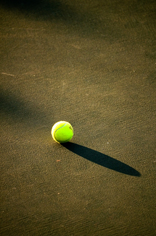Do I need Sports Tile?

No, you don't need sports tile. So why do people buy it? Sports tile offers several benefits, including cushion, aesthetics, less maintenance, and improved safety. Most sports tile, regardless of brand, will absorb shock just because of the properties of plastic. In addition to offering vertical shock absorption when a player lands hard on the court, a substantial amount of force is absorbed by the interlocking design of sports tile. Because the surface is made up of hundreds, or thousands, of individual tile, there's a small amount of give between tile that can absorb more than half of the energy that otherwise impacts your legs, hips, back, and joints. And when you fall, 1/2 of the energy of a fall is absorbed by the surface. So a fall at 4 mph on sports tile feels more like a 2 mph fall and without the deep tissue bone bruise that can sideline a player for weeks and weeks. There are differences in some of the brands of sports tile, and the best choice will depend on the games you want to play and the ages of the people enjoying the court.
While individual tile size (25cm x 25cm, 10"x10", 12"x12", etc.) will vary between brands, the texture of the tile is more important. A tile with a strong texture would be better for adult/aggressive play, while the smoother tile appeals to parents of toddlers who intend to ride their "Big Wheel" on the court. Aggressive texture for improved traction, or less textured tile for smaller kids and gentler play.
While individual tile size (25cm x 25cm, 10"x10", 12"x12", etc.) will vary between brands, the texture of the tile is more important. A tile with a strong texture would be better for adult/aggressive play, while the smoother tile appeals to parents of toddlers who intend to ride their "Big Wheel" on the court. Aggressive texture for improved traction, or less textured tile for smaller kids and gentler play.
Painting the Surface instead of Tile

Sports tile can double the cost of a court project and is clearly not for everyone. And a court without tile is better than no court at all. The argument against painting is that you have a surface that needs periodic sweeping or it becomes slippery with the accumulation of sand, pollen, and dirt. A painted court surface also requires more frequent painting. So it's entirely possible that over a 10-year period, repeated paintings, plus the added maintenance and reduced safety, costs more in the long run. If you're avoiding sports tile because of the cost, go with the concrete and you can always add sports tile later.
What About Using The Coating On City Tennis Courts?

Municipal courts are typically surfaced by the lowest bidder. And the benefit of those surfaces are primarily aesthetic. They're usually applied with a squeegee and a paint roller and aside from texture - offer no cushion or forgiveness.
First a leveling layer and crack filler is applied, and then a "cushion layer" is rolled on, and last is the topcoat with sand added to the mix. The brochures or online descriptions for these products usually include an enlarged view so that you can see each layer more clearly. That's because these layers are the thickness of a layer of paint, or a plastic trash bag. How much cushion can a layer of paint provide? These surfaces also require reapplication every few years and are applied by professionals. They're messy and take days to complete. And again, city contracts usually go to the lowest bidder.
First a leveling layer and crack filler is applied, and then a "cushion layer" is rolled on, and last is the topcoat with sand added to the mix. The brochures or online descriptions for these products usually include an enlarged view so that you can see each layer more clearly. That's because these layers are the thickness of a layer of paint, or a plastic trash bag. How much cushion can a layer of paint provide? These surfaces also require reapplication every few years and are applied by professionals. They're messy and take days to complete. And again, city contracts usually go to the lowest bidder.